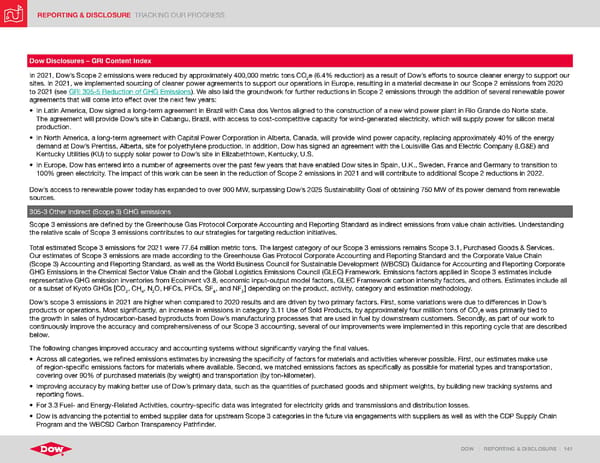REPORTING & DISCLOSURE TRACKING OUR PROGRESS DOW | REPORTING & DISCLOSURE | 141 Dow Disclosures – GRI Content Index In 2021, Dow’s Scope 2 emissions were reduced by approximately 400,000 metric tons CO 2 e (6.4% reduction) as a result of Dow’s efforts to source cleaner energy to support our sites. In 2021, we implemented sourcing of cleaner power agreements to support our operations in Europe, resulting in a material decrease in our Scope 2 emissions from 2020 to 2021 (see GRI 305-5 Reduction of GHG Emissions ). We also laid the groundwork for further reductions in Scope 2 emissions through the addition of several renewable power agreements that will come into effect over the next few years: • In Latin America, Dow signed a long-term agreement in Brazil with Casa dos Ventos aligned to the construction of a new wind power plant in Rio Grande do Norte state. The agreement will provide Dow’s site in Cabangu, Brazil, with access to cost-competitive capacity for wind-generated electricity, which will supply power for silicon metal production. • In North America, a long-term agreement with Capital Power Corporation in Alberta, Canada, will provide wind power capacity, replacing approximately 40% of the energy demand at Dow’s Prentiss, Alberta, site for polyethylene production. In addition, Dow has signed an agreement with the Louisville Gas and Electric Company (LG&E) and Kentucky Utilities (KU) to supply solar power to Dow’s site in Elizabethtown, Kentucky, U.S. • In Europe, Dow has entered into a number of agreements over the past few years that have enabled Dow sites in Spain, U.K., Sweden, France and Germany to transition to 100% green electricity. The impact of this work can be seen in the reduction of Scope 2 emissions in 2021 and will contribute to additional Scope 2 reductions in 2022. Dow’s access to renewable power today has expanded to over 900 MW, surpassing Dow’s 2025 Sustainability Goal of obtaining 750 MW of its power demand from renewable sources. 305-3 Other indirect (Scope 3) GHG emissions Scope 3 emissions are defined by the Greenhouse Gas Protocol Corporate Accounting and Reporting Standard as indirect emissions from value chain activities. Understanding the relative scale of Scope 3 emissions contributes to our strategies for targeting reduction initiatives. Total estimated Scope 3 emissions for 2021 were 77.64 million metric tons. The largest category of our Scope 3 emissions remains Scope 3.1, Purchased Goods & Services. Our estimates of Scope 3 emissions are made according to the Greenhouse Gas Protocol Corporate Accounting and Reporting Standard and the Corporate Value Chain (Scope 3) Accounting and Reporting Standard, as well as the World Business Council for Sustainable Development (WBCSD) Guidance for Accounting and Reporting Corporate GHG Emissions in the Chemical Sector Value Chain and the Global Logistics Emissions Council (GLEC) Framework. Emissions factors applied in Scope 3 estimates include representative GHG emission inventories from Ecoinvent v3.8, economic input-output model factors, GLEC Framework carbon intensity factors, and others. Estimates include all or a subset of Kyoto GHGs [CO 2 , CH 4 , N 2 O, HFCs, PFCs, SF 6 , and NF 3 ] depending on the product, activity, category and estimation methodology. Dow’s scope 3 emissions in 2021 are higher when compared to 2020 results and are driven by two primary factors. First, some variations were due to differences in Dow’s products or operations. Most significantly, an increase in emissions in category 3.11 Use of Sold Products, by approximately four million tons of CO 2 e was primarily tied to the growth in sales of hydrocarbon-based byproducts from Dow’s manufacturing processes that are used in fuel by downstream customers. Secondly, as part of our work to continuously improve the accuracy and comprehensiveness of our Scope 3 accounting, several of our improvements were implemented in this reporting cycle that are described below. The following changes improved accuracy and accounting systems without significantly varying the final values. • Across all categories, we refined emissions estimates by increasing the specificity of factors for materials and activities wherever possible. First, our estimates make use of region-specific emissions factors for materials where available. Second, we matched emissions factors as specifically as possible for material types and transportation, covering over 90% of purchased materials (by weight) and transportation (by ton-kilometer). • Improving accuracy by making better use of Dow’s primary data, such as the quantities of purchased goods and shipment weights, by building new tracking systems and reporting flows. • For 3.3 Fuel- and Energy-Related Activities, country-specific data was integrated for electricity grids and transmissions and distribution losses. • Dow is advancing the potential to embed supplier data for upstream Scope 3 categories in the future via engagements with suppliers as well as with the CDP Supply Chain Program and the WBCSD Carbon Transparency Pathfinder.
 ESG Report | Dow Page 140 Page 142
ESG Report | Dow Page 140 Page 142